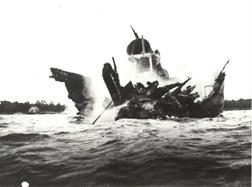Jon Paul’s Maritime Diaries
- Share
- Tweet
- Pin
- Share

The Louisiana was a second generation bulk carrier on the Great Lakes. This photo shows her original configuration of 4 masts. Photo from the E. J. Dowling collection.
The last column featured the R. J. Hackett, the prototype of the first generation of bulk carriers on the Great Lakes. There were 47 of this type built between 1869 and the Great Panic of 1873. Construction of the second generation began in 1880 and 170 vessels would be built during the 1880s; they went over 250 feet in length with engines exceeding 600 horsepower.
The Louisiana was built in 1887 by Morley and Hill at Marine City, Michigan. She was 267 feet in length, with a beam of 39.6 feet, and a 20-foot depth of hold. Built with a wood hull reinforced with iron cross-bracing, with seven cargo hatches, and four masts, she was 1,929 gross tons, 1,383 net. Her engine came from Dry Dock Engine Works of Detroit and was a steam powered 2-cylinder fore and aft compound engine with 26 and 48 inch pistons and 40 inch stroke that developed 610 horsepower. Her boiler was also produced by Dry Dock Engine Works and was a fire-box-type boiler 10 feet in diameter and 15 feet 8 inches long.
The Louisiana ran the usual route down bound with coal and returned with iron ore or grain. Her four masts would prove to be meddlesome when loading or unloading and by 1889 would be reduced to only her foremast and a small stern flagmast.

The Louisiana after the fire, her smokestack rising above the wreckage. Photo from the Jackson Harbor Fishing Museum.
The Louisiana was in service for 26 years and in 1913 was owned by Frank M. Osborne and hailed out of Cleveland Ohio under the command of Captain Fred McDonald. The Louisiana departed Lorain, Ohio on November 2, 1913 with a load of coal for Milwaukee. After delivering her cargo to Milwaukee she left light for Escanaba, Michigan for iron ore. She made it through Death’s Door and about midnight on Friday, November 7 started to stray from her course. A storm which was blowing out of the southwest persuaded Captain McDonald to seek the refuge of the lee in Washington Harbor, situated on the northwest side of the island. She made it to Washington Harbor and dropped her anchors hoping to ride out the storm in safety. In the early morning of Saturday, November 8 the winds turned and started to blow from the northwest and the vessels that took refuge in Washington Harbor were in trouble.
The Louisiana started to drag her anchors and was beached on the southeast side of the harbor. Shortly after the grounding, the vessel started on fire in the hold and the crew of 17 were unable to extinguish the blaze. They took to the yawl boat for the short trip to shore. She was valued at $15,000 at the time of her loss. The Leathem & Smith Towing and Wrecking Co. purchased the machinery from the underwriters in 1918, and in 1920 the boiler was finally recovered and the job completed.

The site plan of the Louisiana can be deceiving to look at because the bow is broken off and on the beach – the pointed end is actually the stern. Site plan created by the Wisconsin Historical Society, Maritime Preservation and Archaeology Program.
Today the stern lies in 18 feet of water with the forward end almost touching the surface, a large section of the bow is washed ashore a short distance away. The wreck of the Louisiana is a good dive/snorkel site but it is located off of private property so a boat is required to visit it. The Wisconsin Historical Society has placed a Maritime Trail sign on School House Beach with pictures and history of the vessel.
